Ricky
Ian Gordon,
The Grapes of Wrath: (2007, world
premiere)
Libretto
by Michael Korie, based on the novel by John Steinbeck,
The Minnesota Opera, Grant Gershon (conductor), Ordway
Center for the Performing Arts, St. Paul, Minnesota, 17.02.2007
(BH)
Original stage direction and dramaturgy by Eric Simonson
Orchestrations by Ricky Ian Gordon and Bruce Coughlin
Co-commissioned by The Minnesota
Opera and Utah Symphony & Opera.
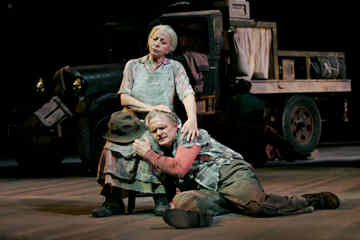
Production
Conductor:
Grant Gershon
Stage
Director:
Eric Simonson
Choreographer:
Doug Varone
Set Designer:
Allen Moyer
Costume
Designer:
Kärin Kopischke
Lighting
Designer:
Robert Wierzel
Cast
Tom Joad:
Brian Leerhuber
Ma Joad:
Deanne Meek
Rosasharn:
Kelly Kaduce
Jim Casy:
Roger Honeywell
Pa Joad:
Peter Halverson
Uncle John:
Robert Orth
Granma:
Rosalind Elias
Grampa:
Dan Dressen
Connie Rivers:
Jesse Blumberg
Noah:
Andrew Wilkowske
Al:
Joshua Kohl
Ruthie:
Maeve Moynihan
Winfield:
Henry Bushnell
Featured
ensemble:
Theodore Chletsos, Anna Jablonski, Kelly Markgraf, Gregory Pearson, Karin
Wolverton
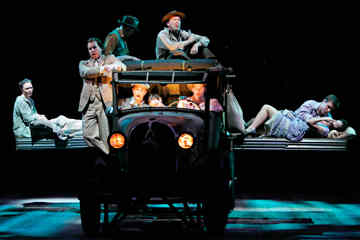
Imagine an Oklahoma sky, clouds hypnotically drifting
by, towering over rows of yellow and green cornstalks
below. Put this on high-definition television and
you have an idea of Allen Moyer’s opening set for The
Grapes of Wrath, which arrestingly telegraphed the
novel’s initial optimism. But in the rear of the
stage one could already glimpse a sober metal catwalk
on three sides, and behind that, the back wall covered
with rusted, corrugated steel. As the corn dies,
the idyllic sky disappears, and the Joads’ misfortunes
begin, the wall’s lower half becomes an ever-changing
panorama of cracked brown earth, frightening dust storms
or Orwellian Depression-era housing, all evoked with crystal-clear
rear projection video. I know some opera-lovers
deplore the use of this technology (“Just build the sets!”)
but this particular novel would require perhaps twenty
locales to capture its range, and Moyer came up with a
creative and satisfying way of showing the mounting tides
of grim desolation as a Depression-era family finds itself
up against monumental forces out of its control.
Later an authentic 1929 truck, complete with a busted
taillight, serves as a kind of sad lifeboat, the entire
Joad family clinging to all sides. Kärin Kopischke’s
grim costumes seem so right, so natural that they virtually
fade into the production, and lighting designer Robert
Wierzel captures every bit of darkness, dust-filled day
and (sometimes) moonlit night.
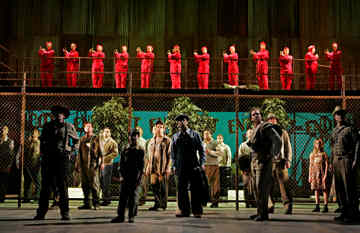
It is a bit
surprising that this epic has taken so long to reach the operatic stage, but the
Steinbeck estate has rebuffed many composers over the years until Ricky Ian
Gordon was granted the rights, and indeed he might be the ideal man for this
daunting job. Gordon’s language, a sort of opera-Broadway hybrid, seems rooted
in Bernstein, Copland, and Carlisle Floyd, with some American musical
conventions peeking through now and then. Especially in Act I, a handful of the
scenes seemed to have a more conventional Broadway structure, with quick musical
“wrap-ups” that seem unashamedly designed to cue applause, rather than phrases
that find unexpected endings. But much of the time his choices are
overwhelmingly effective, and his use of American popular music neatly parallels
the story (such as a square dance, that also shows off the expertise of
choreographer Doug Varone). Stirring set pieces involve the entire group, such
as the opening, “The Last Time There Was Rain,” with its depiction of endless
dust:
“In the pitch
plack nights
not a star
shone through!
Not
a light bulb lit
more’n a yard
or two!
And when dawn
would break,
there would
be no day,
just a dull
red glow behind the gray…”
Act
II opens in a diner along Route 66, where a chorus of
waitresses (think The Andrews Sisters) cheerily berate
“Okies” who want handouts, versus the truck drivers who
are their best customers. Later the Joads cross
the Mojave Desert, eventually reaching the Endicott Canneries,
before finding themselves mired in Hooverville, a depressing
shantytown whose mirage of opportunity quickly evaporates.
A fire destroys much of the plum crop, the pregnant Rosasharn
is abandoned by her husband, a woman is shot and a key
character kills himself. The final act is played
out first in the white porcelain of a washroom in a government
settlement camp, as the final sequence of events rain
down on the Joads, pelting them much like the relentless
storms throughout the opera.
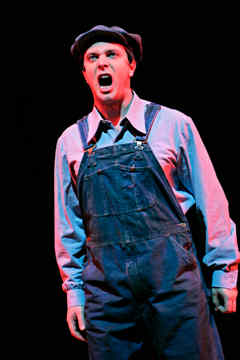
Michael
Korie’s libretto sifts through Steinbeck’s 400-plus pages and emerges with a
powerfully literate story. If now and then some decisions may disorient those
following the book, Korie has exercised his prerogative to translate the printed
page in search of dramatic coherence and intensity. In the novel, Noah’s demise
is somewhat ambiguous, but Korie gives him one of the opera’s most haunting
scenes, vividly conceived by director Eric Simonson. A young Ma Joad
(outstandingly portrayed by Deanne Meek) appears and sings about the infant
Noah: “No innocence like the dream of a simple child…no innocence like a
child with a simple dream.” As Meek is center stage, floating high above
her is the adult Noah (achingly acted and sung by Andrew Wilkowske) carrying a
heavy bucket of rocks. Against a backdrop of darkly lapping water, as the song
reaches its piercing climax, his hands slowly release the bucket and he drowns
himself.
Among the
outstanding vocal talent on display at the Ordway Center, Brian Leerhuber was
indomitable as Tom Joad, whose famous speech after he emerges from hiding has
been transformed into an appropriately monumental ode, ending with:
“…In prison
cells an’ holdin’ pens
my back
ag’inst a wall.
By firin’
squad, by hangin’ tree,
electric
chair an’ all…
I’ll be
there,
but I won’t
fear it
becuz my
spirit be free.
I’ll be there
like you is
always for me.
I’ll be
there, I’ll be there.
You’ll
see.”
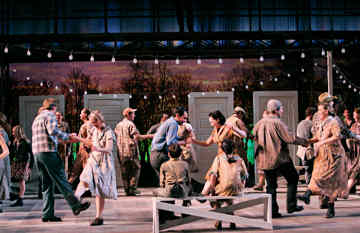
He was
matched by Meek’s searing Ma Joad, whose soaring lines were riveting and painful
without becoming harsh, and she was nicely paired with Peter Halverson’s
forceful Pa, singing with increasing desperation. As the lapsed preacher, Jim
Casy, Roger Honeywell had many moving moments, climaxing with “Things Turn
Around,” his sad duet with Tom in Act III. Joshua Kohl was very effective as
Noah’s brother Al, whose stinging comments ignite more tragedy. Dan Dressen
made a ruggedly convincing Grampa, with veteran Rosalind Elias offering a
nuanced Granma, both sadly exiting too soon.
In
another slight departure from the book, Rosasharn virtually
anchored the story, and Kelly Kaduce’s voice was a pleasure
– albeit a heartbreaking one – in every scene in which
she appeared. As Connie, who abandons her, Jesse
Blumberg used his strong baritone to make the most of
the pathos. Robert Orth made a stern Uncle John,
powerfully leading the cast in one of the final gripping
scenes when Rosasharn’s dead child is found. An
excellent small ensemble featured Theodore Chletsos, Anna
Jablonski, Kelly Markgraf, Gregory Pearson and Karin Wolverton.
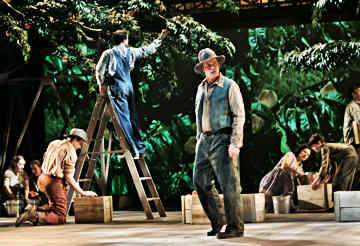
Grant Gershon, renowned for his work with the Los Angeles
Master Chorale, moved through the score with as much swiftness
and focus as possible, making the long evening seem less
so. Occasionally balance problems made one glad
for the surtitles, but it was hard to tell whether the
hall itself, or some discreet amplification were minor
culprits. (I thought the two excellent children,
Henry Bushnell and Maeve Moynihan, were gently, appropriately
miked to prevent them from having to scream.) But
Gershon never called attention to his interpretation,
and elicited bravura work from everyone onstage, as well
as the gleaming Minnesota Opera Orchestra and Chorus.
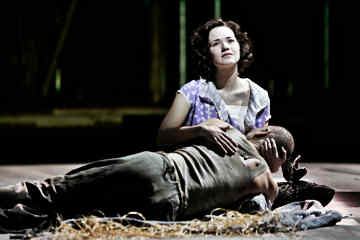
At four hours
long, including two intermissions, the work might be tightened just a bit. The
cannery scene in Act II, funny as it is, seems to be handing the audience some
humor to offset the relentless tread, the growing clouds of misfortune.
Steinbeck doesn’t flinch in telling a tough story, and I think the overall
impact might be that much greater without any attempt to ameliorate the
nihilistic message. The final devastating scene, which the film version
carefully sidestepped, is faithful to the book, and unfurled with haunting
immediacy by Ms. Kaduce. An implacable universe tosses Rosasharn an unexpected
opportunity to save someone else, in a way she could never imagine.
Bruce
Hodges
All
photos © Michal Daniel 2007









